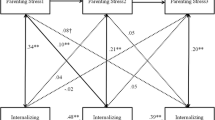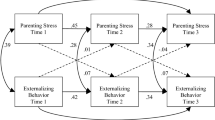Abstract
This study examined maternal parenting stress in a sample of 430 boys and girls including those at risk for externalizing behavior problems. Children and their mothers were assessed when the children were ages 2, 4, and 5. Hierarchical linear modeling (HLM) was used to examine stability of parenting stress across early childhood and to examine child and maternal factors predicting parenting stress at age 2 and changes in parenting stress across time. Results indicated that single parenthood, maternal psychopathology, child anger proneness, and child emotion dysregulation predicted 2-year parenting stress. Child externalizing behaviors predicted initial status and changes across time in parenting stress. Stability of parenting stress was dependent upon child externalizing problems, as well as interactions between child externalizing problems and gender, and child externalizing problems and emotion regulation. Results are discussed in the context of mechanisms by which parenting stress may influence the development of child externalizing behaviors.


Similar content being viewed by others
References
Abidin, R. R. (1990). Introduction to the special issue: The stresses of parenting. Journal of Clinical Child Psychology, 19, 298–301.
Abidin, R. R. (1992). The determinants of parenting behavior. Journal of Clinical Child Psychology, 21(4), 407–412.
Abidin, R. R. (1995). Manual for the Parenting Stress Index. Odessa, FL: Psychological Assessment Resources.
Achenbach, T. M. (1991). Manual for the Child Behavior Checklist/4-18 and 1991 profile. Burlington, VT: Department of Psychiatry, University of Vermont.
Achenbach, T. M. (1992). Manual for the Child Behavior Checklist/2-3 and 1992 profile. Burlington, VT: Department of Psychiatry, University of Vermont.
Aiken, L. S., & West, S. G. (1991). Multiple regression: Testing and interpreting interactions. Newbury Park, CA: Sage.
Anthony, L. G., Anthony, B. J., Glanville, D. N., Naiman, D. Q., Waanders, C., & Shaffer, S. (2005). The relationships between parenting stress, parenting behaviour and preschoolers’ social competence and behaviour problems in the classroom. Infant and Child Development, 14, 133–154.
Barry, T. D., Dunlap, S. T., Cotten, S. J., Lochman, J. E., & Wells, K. C. (2005). The influence of maternal stress and distress on disruptive behavior problems in boys. Journal of the American Academy of Child and Adolescent Psychiatry, 44, 265–273.
Benzies, K. M., Harrison, M. J., & Magill-Evans, J. (2004). Parenting stress, marital quality, and child behavior problems at age 7 years. Public Health Nursing, 21, 111–121.
Calkins, S. D., (2002). Does aversive behavior during toddlerhood matter? The effects of difficult temperament on maternal perception and behavior. Infant Mental Health Journal, 23, 381–402.
Calkins, S. D. & Dedmon, S. A. (2000). Physiological and behavioral regulation in two-year-old children with aggressive/destructive behavior problems. Journal of Abnormal Child Psychology, 2, 103–118.
Calkins, S. D., Dedmon, S. E., Gill, K. L., Lomax, L. E., & Johnson, L. M. (2002). Frustration in infancy: Implications for emotion regulation, physiological processes, and temperament. Infancy, 3, 175–197.
Calkins, S. D., Gill, K. A., Johnson, M. C., & Smith, C. (1999). Emotional reactivity and emotion regulation strategies as predictors of social behavior with peers during toddlerhood. Social Development, 8, 310–341.
Calkins, S. D., & House, R. (2004). Individual differences in self-regulation: Implications for childhood adjustment. In P. Philipot & R. Feldman (Eds.), The regulation of emotion (pp. 307–332). Mahwah, NJ: Lawrence Erlbaum.
Calkins, S. D., Hungerford, A., & Dedmon, S. (2004). Mothers’ interactions with temperamentally frustrated infants. Infant Mental Health Journal, 25, 219–239.
Calkins, S. D., & Johnson, M. C. (1998). Toddler regulation of distress to frustrating events: Temperamental and maternal correlates. Infant Behavior and Development, 21, 379–395.
Campbell, S. B. (2002). Behavior problems in preschool children: Clinical and developmental issues (2nd ed.). New York: Guilford Press
Chang, Y., Fine, M. A., Ispa, J., Thornburg, K. R., Sharp, E., & Wolfenstein, M. (2004). Understanding parenting stress among young, low-income, African-American, first-time mothers. Early Education and Development, 15, 265–282.
Cole, P. M., Martin, S. E., Dennis, T. A. (2004). Emotion regulation as a scientific construct: Methodological challenges and directions for child development research. Child Development, 75, 317–333.
Copeland, D., & Harbaugh, B. L. (2005). Differences in parenting stress between married and single first time mothers at six to eight weeks after birth. Issues in Comprehensive Pediatric Nursing, 28, 139–152.
Crnic, K. A., Gaze, C., & Hoffman, C. (2005). Cumulative parenting stress across the preschool period: Relations to maternal parenting and child behaviour at age 5. Infant and Child Development, 14, 117–132.
Crnic, K. A., & Greenberg, M. T. (1990). Minor parenting stresses with young children. Child Development, 61, 1628–1637.
Crnic, K., & Low, C. (2002). Everyday stresses and parenting. In M. H. Bornstein (Ed.), Handbook of parenting: Vol. 5: Practical issues in parenting (2nd ed., pp. 243–367). Mahwah, NJ: Lawrence Erlbaum Associates.
Cummings, E. M., & Davies, P. T. (1995). The impact of parents on their children: An emotional security hypothesis. Annals of Child Development, 10, 167–208.
Cummings, E. M., Keller, P. S., & Davies, P. T. (2005). Towards a family process model of maternal and paternal depressive symptoms: Exploring multiple relations with child and family functioning. Journal of Child Psychology and Psychiatry, 46, 479–489.
Davies, L., Avison, W. R., McAlpine, D. D. (1997). Significant life experiences and depression among single and married mothers. Journal of Marriage and the Family, 59, 294–308.
Deater-Deckard, K. (2005). Parenting stress and children’s development: Introduction to the special issue. Infant and Child Development, 14, 111–115.
Derogatis, L. R. (1994). Manual for the symptom checklist 90 revised (SCL-90R). Baltimore, MD: Author.
Derogatis, L. R., & Cleary, P. A. (1977). Conformation of the dimensional structure of the SCL-90: A study in construct validation. Journal of Clinical Psychology, 33, 981–989.
Durbin, C. E., Klein, D. N., Hayden, E. P., Buckley, M. E., & Moerk, K. C. (2005). Temperamental emotionality in preschoolers and parental mood disorders. Journal of Abnormal Psychology, 114, 28–37.
Eisenberg, N., Cumberland, A. L., Spinrad, T. L., Fabes, R., Shepard, S. A., Reiser, M., Murphy, B. C., Losoya, S. H., & Guthrie, I. K. (2001). The relations of regulation and emotionality to children’s externalizing and internalizing problem behavior. Child Development, 72, 1112–1134.
Else-Quest, N. M., Hyde, J. S., Goldsmith, G. G., & Van Hulle, C. A. (2006). Gender differences in temperament: A meta-analysis. Psychological Bulletin, 132, 33–72.
Garson, G. D. (2006). Data Imputation for Missing Values. Retrieved February 1, 2006, from North Carolina State University, PA765: Quantitative Research in Public Administration Web site: http://www2.chass.ncsu.edu/garson/pa765/missing.htm
Goldsmith, H. H. (1996). Studying temperament via construction of the Toddler Behavior Assessment Questionnaire. Child Development, 67, 218–235.
Goldsmith, H. H., & Rothbart, M. K. (1993). The laboratory temperament assessment battery: Locomotor version 2.02 (LAB-TAB). University of Wisconsin.
Hinshaw, S. P. (1992). Externalizing behavior problems and academic underachievement in childhood and adolescence: Causal relationships and underlying mechanisms. Psychological Bulletin, 111, 127–155.
Hinshaw, S. P. (2002). Process, mechanism, and explanation related to externalizing behavior in developmental psychopathology. Journal of Abnormal Child Psychology, 30, 431–446.
Hollingshead, A. B. (1975). Four-factor index of social status. Unpublished manuscript, New Haven, CT: Yale University.
Kass, R. E., & Raftery, A. E. (1995). Bayes factors. Journal of the American Statistical Association, 90, 773–795
Kazdin, A. E., & Whitley, M. K. (2003). Treatment of parental stress to enhance therapeutic change among children referred for aggressive and antisocial behavior. Journal of Consulting and Clinical Psychology, 71, 504–515.
Keenan, K., & Shaw, D. (1994). The development of aggression in toddlers: A study of low income families. Journal of Abnormal Child Psychology, 22, 53–78.
Keenan, K., & Shaw, D. (1997). Developmental and social influences on young girls’ early problem behavior. Psychological Bulletin, 121, 95–113.
Lehman, E. B., Steier, A. J., Guidash, K. M., & Wanna, S. Y. (2002). Predictors of compliance in toddlers: Child temperament, maternal personality and emotional availability. Early Child Development and Care, 172, 301–310.
Little, R., & Rubin, D. (2002). Statistical analysis with missing data (2nd ed.). NY: Wiley-Interscience.
Loeber, R., Wung, P., Keenan, K., Girouz, B., Stouthhamer-Loeber, M., Van Kammen, W. B., & Maughan, B. (1993). Developmental pathways in disruptive child behavior. Development and Psychopathology, 5, 103–133.
Misri, S., Reebye, P., Milis, L., & Shah, S. (2006). The impact of treatment intervention of parenting stress in postpartum depressed mothers: A prospective study. American Journal of Orthopsychiatry, 76, 115–119.
Moffitt, T. E., & Caspi, A. (2001). Childhood predictors differentiate life-course persistent and adolescence-limited antisocial pathways among males and females. Development and Psychopathology, 13, 355–375.
Morgan, J., Robinson, D., & Aldridge, J. (2002). Parenting stress and externalizing child behaviour. Child ande Family Social Work, 7, 219–225.
Ostberg, M., & Hagekull, B. (2000). A structural modeling approach to the understanding of parenting stress. Journal of Clinical Child Psychology, 29, 615–625.
Podolski, C., & Nigg, J. T. (2001). Parent stress and co** in relation to child ADHD severity and associated child disruptive behavior problems. Journal of Clinical Child Psychology, 30, 503–513.
Qi, H. K., & Kaiser, A. P. (2003). Behavior problems of preschool children from low-income families: Review of the literature. Topics in Early Childhood Special Education, 23, 188–216.
Raudenbush, S. W., & Bryk, A. S. (2002). Hierarchical linear models: Applications and data analysis methods (2nd ed.). Newbury Park, CA: Sage.
Ricciuti, H. N. (2004). Single parenthood, achievement and problem behavior in white, black and Hispanic children. Journal of Educational Research, 97, 196–206.
Rogosa, D., Brant, D., & Zimowski, M. (1982). A slow growth curve approach to the measurement of change. Psychological Bulletin, 92, 726–748.
Singer, J. D., & Willett, J. B. (2003). Applied longitudinal data analysis: Modeling change and event occurrence. New York: Oxford University Press.
Sheinkopf, S. J., Lester, B. M., LaGasse, L. L., Seifer, R., Bauer, C. R., Shankaran, S., Bada, H. S., Poole, W. K., & Wright, L. L. (2005). Interactions between maternal characteristics and neonatal behavior in the prediction of parenting stress and perception of infant temperament. Journal of Pediatric Psychology, 31, 27–40.
Stifter, C. A., & Braungart, J. M. (1995). The regulation of negative reactivity in infancy: Function and development. Developmental Psychology, 31, 448–455.
Webster-Stratton, C. (1990). Stress: A potential disruption of parent perceptions and family interactions. Journal of Clinical Child Psychology, 19, 302–312.
Webster-Stratton, C. (1999). The incredible years. The parents and children series. Seattle, WA: Seth Enterprises.
Acknowledgements
This research was supported by National Institute of Mental Health (NIMH) awards (MH 55625 and MH 58144) to the second author and an NIMH award to the second and third authors (MH 55584). We thank the parents and children who have repeatedly given their time and effort to participate in this research. Additionally, we are grateful to the entire RIGHT Track staff for their help in data collection, entry, checking, coding etc.
Author information
Authors and Affiliations
Corresponding authors
Rights and permissions
About this article
Cite this article
Williford, A.P., Calkins, S.D. & Keane, S.P. Predicting Change in Parenting Stress Across Early Childhood: Child and Maternal Factors. J Abnorm Child Psychol 35, 251–263 (2007). https://doi.org/10.1007/s10802-006-9082-3
Received:
Accepted:
Published:
Issue Date:
DOI: https://doi.org/10.1007/s10802-006-9082-3




